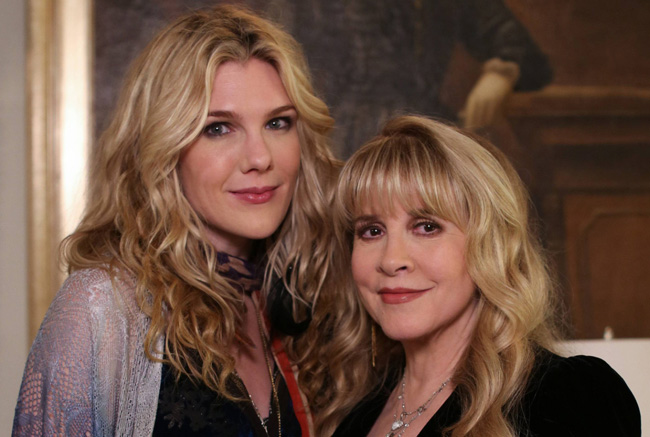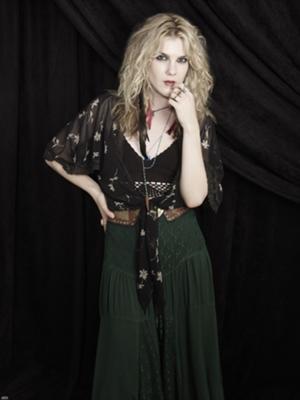How ‘American Horror Story: Coven’ Should Have Ended

Source: Huffingtonpost.com
I’m not one to tell people how to interpret art of any kind. Popular “you’re enjoying this thing wrong!” articles give me heartburn. I thought Coven, the third season of FX’s American Horror Story, was great at the story part, and chock full of delicious Cajun Americana. What I don’t know is that it was a horror story. To wit, I provide an alternate endgame for American Horror Story that, to me, does the legend of the witch a much better horror treatment. The one it deserves. And it’s all about Misty Day.

Warning: This article is spoiler-heavy and I don’t leave anything out. If you haven’t watched the season finale and don’t want to be spoiled, stop reading now.
[divider]
The beginning of the final episode, The Seven Wonders,was just awesome. A little cheesy, but if Stevie Nicks singing to hardworking young witches in a beautiful historical New Orleans home in fabulous outfits doesn’t give you chills, you’re watching the wrong show. The young witches compete to see who will be the Supreme witch, the new head of the Coven. We’ve been wondering about this since Episode 2, really, but we never considered the Covenless hippie chick, not seriously.
Way back then in Episode 2, we meet Misty Day. Misty gets a lot of heavy symbolism thrown at her right off the bat – she can die and resurrect herself and others, which is a pretty choice power to have. And like most kids with Chosen One level powers, she lives off the grid. Her powers isolate her from the rest of her family – and because this is a horror story and not Harry Potter or Star Wars – she is cast out by them and burned at the stake.
So Misty Day becomes the storybook witch of the wilds, hiding in the swamp. It’s this image that’s important to come back to, I think, to keep this a horror story. To ignore this part of the legend of witchcraft does the whole thing a big disservice. Witches can represent a lot of things, and they do. Ryan Murphy does a great job of reminding you that it’s not just the cigarette smoking, dagger-wielding Jezebels and Salomes of the witch world that can be deadly, it’s the little girls, too. Coven provides us with girls like Zoe, Queenie, and Nan, who are downright merciless – after all, power corrupts. So between the Jezebels (like Taco Supreme Fiona Goode and Surprise Bitch Madison Montgomery) and the Little Girls, we’ve got a pretty fierce dichotomy of witches. Murphy also does the great job of breaking that dichotomy with eccentric fashionistas like Myrtle Snow, and of course, Cordelia Goode. Delia is an interesting character, no doubt. Her meekness in the face of abuse is a show of willpower most of us don’t have, and it’s that restraint that keeps her from realizing her true place as the next Supreme. I get it. From a character development point, it’s great for Delia. But for us, it just leaves something lacking. It’s not narratively satisfying, not for a horror story. And the reason for that is witches in huts, on hills, and in swamps. Spooky witches. Blair Witches. Misty Day.
So here are my thoughts. Misty Day is lonely. The idea of a coven appeals to her because they have pretty clothes and a nice house and a cute blonde boy and they make friends with each other. They don’t have to talk to their radios all day. They live in the city of beignets. But imagine you’re so lonely, and you remember this family who burned you at the stake, and you get taken in by a new family. Even worse than the old one, really. At least your old family didn’t really have any ability to cast the curses they slung at you. This one does. And wouldn’t you know it, they still burn people at the stake. It’s almost like a bunch of powerful people banding together is a bad idea, or something. It’s almost like the coven shouldn’t exist, like Miss Robichaux’s is a hotbed for a pattern of violence and abuse, almost like witches are better off alone, as storybook creatures in swamps and huts. At least, this is what you maybe think if you’re Misty Day.
So here’s my alternate proposal ending: Misty gets unboxed and comes back to have her epic fight with Madison Montgomery. Misty goes from not wanting to be the Supreme and maybe being the Supreme to definitely being the Supreme. She fights for it. Because only as the Supreme can she have the power to disband and destroy this coven, so witches can wander and be themselves, alone. Just like Stevie Nicks.
Covens aren’t necessary. The Supreme doesn’t achieve any higher enlightenment that’s better for witches as a whole, she just paints a target on her back. The whole idea of the Supreme encourages the kind of infighting that people think women live for but we actually kind of hate. But Stevie doesn’t play that. Stevie waltzes in and out of Miss Robichaux’s as she damn well pleases, and Misty Day sees that. And wouldn’t you know it? Misty says that’s the way it’s going to be for witchdom as a whole. We’re all gonna do it like Stevie does it.
The only way that happens is if the Supreme’s power is somewhere they can’t get to it so the coven can be truly disbanded, and the best way for Misty Day to do that is to gain it for herself and wander away, taking it. At least for her lifetime, the Supreme leads no coven, hides in the woods, and forcibly destroys the coven of Miss Robichauxs. There are some great ways she could do it, but ultimately it doesn’t matter. There are a lot of ways to damn someone to a life of loneliness. Queenie seems happy with her paradigm shift, Nan is dead, and Zoe is literally untouchable. Aside from Madison, most of these girls are on the run from families or crimes they’ve committed and would have to go into hiding anyway. Myrtle Snow’s not so hard to kill – her hair’s so big because it’s full of guilt – and Delia isn’t really a fighter. It narratively makes sense for Misty to dispatch the others in some way in the name of disbanding the coven. She breaks up the bad family and goes back to the woods.
The other loose ends tie themselves up – Fiona dies of her cancer when a new Supreme takes her spot, and our other two HWICs are playing pattycake in Hell. Our witch-hunters were neatly dealt with, and the fundamentalist neighbors are dead. It’s an old house, all that antique furniture would burn nicely with some help from your pyrokinesis, M-Dizzle. Maybe she dies in the process with them and rises from the ashes. Again. As she does. Maybe she can’t let them die, so she takes the girls to the four corners of nowhere and raises them from the dead, packs them in mud, so they wake up in the middle of nowhere, separated and alone.
Misty’s end in the series felt borderline ignoble – her Hell revealed nothing about her that we didn’t already know, that she is a good, kind and sweet person that won’t kill for meaningless reasons. How great would it have been to see her survive that trip into the afterlife and learn from it? That nothing should die for empty reasons – but maybe evil people should die for good ones. To watch our little hippie turn into a fierce utilitarian in the name of preserving the ideals of storybooks and Stevie Nicks? That’s good horror, in my opinion.
As for Tate? Well, Misty wanted his company anyway. She wasn’t bothered by keeping him prisoner in the first place, and his mind is about as difficult to melt as Jell-O. Take the Franken-boy and return to the swamp, leave Miss Robichaux’s a crater in the street, and voila Ryan Murphy, you’ve turned your witches from fashion plates into monsters. They go from being Beauxbatons students in Gaultier to what they once were in legend: mysterious, lonely, powerful, dangerous women with lives impossibly different from our own. They become horror characters again.
This fixes the current ending, which, in my opinion, was less horror and more supernatural fantasy. Call me cynical, but I don’t like my horror movies to end with everything tied up neatly. I think most of us don’t. It’s hard to remember why you’re scared if all the bad guys have been dispatched at the very end. Our best girl, the one we’ve all been rooting for from the very beginning, gets her ending. It’s not black or white, it’s not bad or good. It’s the grey path. It’s narrative witchcraft.
I felt Ryan Murphy’s love all over this season, I really did. As a girl who will always read her horoscope, burn votives, and own a dusty, dog-eared copy of Drawing Down the Moon, I felt it too. If my own friends had written that story, it would have been Tori Amos instead of Stevie Nicks, but largely the same music video. I felt like he fell too in love with sisterhood and the idea of witchcraft as a beautiful bond to really make his story scary. I wanted more The Craft and less Practical Magic, okay? More Buffy than Charmed. “Sabrina the Teenage Cracker,” as Queenie would say.
Just consider it, is all I’m saying. You know I’d take a job in that writing room any day.



